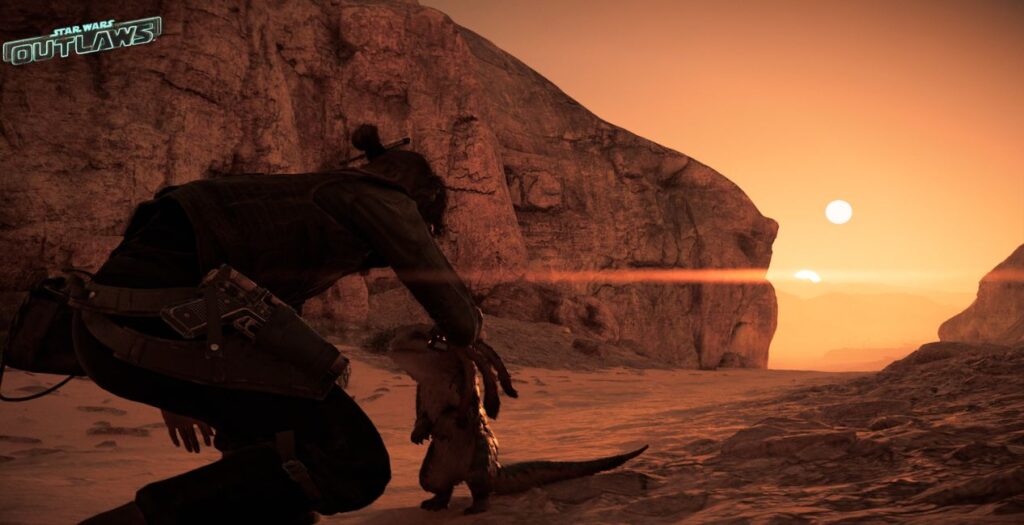Star Wars Outlaws pulls players deeper into the Star Wars universe than any game since Star Wars Galaxies. Over 20 years ago, I spent countless hours running around the galaxy, captivated by the fauna that inhabited it. Back then, I loved nothing more than exploring the fauna, which led me to become a creature handler, focusing more on training pets than interacting with other players. Fast forward to now, and Star Wars Outlaws has reignited that passion, offering a galaxy teeming with creatures old and new.
One of my biggest complaints about Jedi: Fallen Order was overemphasizing battling fauna rather than truly appreciating them. Star Wars Outlaws flips that on its head, providing a world where you can engage with and pet more creatures than you ever imagined. Not only do we get to journey with Kay Vess (Humberly González) and her trusty merqaal companion, Nix, but we can also pet various fauna across different planets.
Here are six other fauna you can pet across various planets, proving that Star Wars Outlaws offers a more peaceful and immersive connection with the Star Wars galaxy.
Tatooine
Banthas

These massive, hairy creatures may not have the best odor, but their resemblance to cows or elephants from our world makes them irresistibly pettable. First introduced in A New Hope—played by Mardji, a 22-year-old female Asian elephant—banthas are domesticated herd animals often used for their milk, meat, and leather. Despite their size, they’re gentle giants, and you can find them wandering the sandy plains of Tatooine. In Outlaws, petting a Bantha is a nostalgic trip down memory lane, connecting players to the rich history of the Star Wars universe.
Dewbacks

While we first saw dewbacks being ridden by Imperial troopers in A New Hope, Outlaws offers a much softer side to these thick-skinned reptiles. Nix might be a little scared of them, prompting a dewback herder to move them aside gently, showcasing their docile nature. Native to Tatooine, dewbacks are known for their resilience and durability, making them popular mounts. Their calm demeanor makes them a joy to interact with, whether you’re admiring them from afar or giving them a quick pat.
Scurriers

These small, skittish rodents are often found scurrying around the outskirts of settlements on Tatooine. While they tend to scatter at the slightest threat, their presence is a charming reminder of the rich ecosystem of the desert planet. Introduced in the A New Hope special edition, scurriers have since appeared in The Book of Boba Fett and The Mandalorian. Though small and quick, if you’re patient enough, you might just catch a moment to appreciate these tiny creatures.
Toshara
Robumas

New to the Star Wars canon, robumas are herd animals native to Toshara. The first refugees on the planet domesticated these mammal herbivores and are now an integral part of Tosharan culture. You can find wild herds roaming the savanna, where they’re more than happy to accept a gentle pet. Robumas are essential to the local economy, providing milk, meat, and leather, and are often seen grazing peacefully in designated territories.
Gushiros

Another new addition to the Star Wars universe, gushiros are small, evasive mammals that roam the shrublands of Toshara. Though they’re too quick to pet directly, you can toss them a treat, earning their brief attention. Gushiros are typically found hunting for insects or scavenging in settlements, often breaking into garbage containers. Their presence in cantinas and restaurants might be a nuisance, but these curious creatures add a unique touch to the world, especially when you spot one scurrying around in the game’s quieter moments.
Kijimi
Henku

If you’re familiar with highland cows, henku might seem like their Star Wars equivalent—fluffy, cold-loving relatives of the bantha. These large, warm-blooded mammals are ideally suited for the frigid climate of Kijimi. Used as beasts of burden by local fishers, henku are valued for their milk, meat, and leather. While they’re the only fauna you can pet on Kijimi, the interaction is memorable. And if you’re lucky, you’ll witness them blow air through their noses, creating a charming double barrel of condensation.







